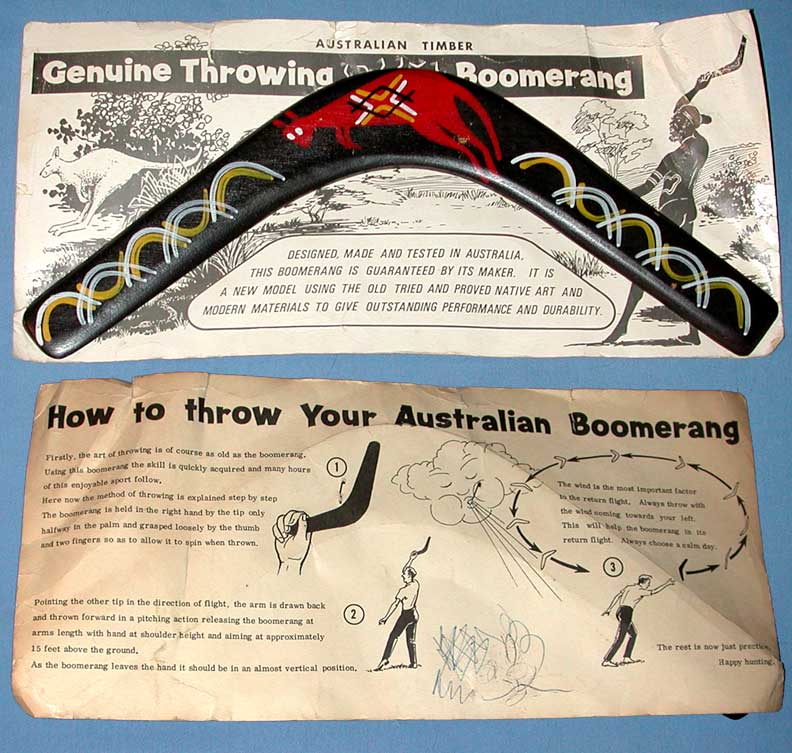Item TB175
This Item was Sold on 19 May 2009
for $99
Similar artifacts for sale are often found on the Aboriginal
Boomerangs web page.
Historical Pricing information for this item and similar artifacts
can be found at: Historical Artifact
Prices.
Australian Aborigines are well known for making
boomerangs. The majority of Aborigines had the technology to
make throwsticks, or non-returning boomerangs. Only a small
percentage of the tribal groups knew how to make true
returners and most of these came from the eastern coastal
regions of Queensland, New South Wales and Victoria. During
the past century, the majority of the Aborigines came out of
the bush and were somewhat assimilated into European man's
culture. Many Aborigines began making returning style
boomerangs to sell to tourists. The earliest ones were well
made out of natural timber and with the grain following the
curvature of the boomerang. Today, most hardwood boomerang
are cut out of a large board and the grain is usually
straight and running parallel to a line spanning the tips of
the blades. Boomerangs that are made with the grain
following the contour of the blades are much stronger and
more valuable. In addition, some boomerangs have good
airfoiling. The majority do not. Most "tourist boomerangs"
have painted upper surfaces that display Australian animals
and decorative lines and/or geometric patterns. Most
pre-contact returners have no artwork or the artwork is
simple and scratched into the surface. It is easy to tell
the tourist boomerang from the valuable ethnographic
artifact. However, tourist boomerangs that are made properly
with the grain running along the contour and with good
airfoiling and artwork do have good collectable value,
especially if they are made by famous Aboriginal artists
like Bill Onus, Lin Onus or Joe Timbery.
Bill Onus was born in Cummeragunja in 1906 . His father
was a drover and young Bill left home at the age of 16. His
earliest political activity in 1929 can be traced to Salt
Pan Creek, an Aboriginal squatters camp south-west of Sydney
containing refugee families of the dispossessed and people
seeking to escape the harsh and brutal policies of the
Aborigines Protection Board becomes a focal point of
intensifying Aboriginal resistance in NSW. Significant alliances, strategies and future leaders were
developed in this camp. People such as Jack Campbell, George
and Jack Patten, Pearl Gibbs all spend time in the camp.
This led to Onus becoming involved on the fringes of the
Aborigines Progressive Association (APA) during the late
1930s. In 1940, after Jack Patten had joned the army, Bill
Onus became the secretary of the APA. During the second
world war Onus was active in the ALP and trade union
circles, at the same time as organizing fund-raising
concerts in the Redfern Aboriginal community. In 1945 he was
a co-founder of the Redfern All-Blacks rugby team. In 1946 he returned to Melbourne where he became
President of the Australian Aborigines League (AAL) and
through his involvement with that organisation organized
support for campaigns such as the 1945 Pilbara strike in WA
and opposition to the Woomera Rocket testing range in
SA. In the early 1950s developed and staged a concert called
'An Aboriginal Moomba out of the dark". He was asked by
Melbourne's city fathers to provide a name for their new
annual civic celebration and he suggested the name "Moomba".
There has been considerable controversy of the years since
as to whether Onus had fooled the festival organizers as
many Aboriginal people have pointed out that "Moom" is a
local indigenous word for 'bum'. In 1952 Onus received an invitation from Walt Disney to
visit the USA but was refused a visa by US authorities on
the grounds of his alleged Communist associations. This
incident is believed to have severly distressed Onus and he
overtly changed his emphasis from political to cultural. Not
long after being refused entry to the US he established
"Aboriginal Enterprises" and opens a boomerang factory and
shop in Belgrave on the edge of Melbourne. He developed an interest in 8mm filmmaking and among the
few surviving snippets of footage he filmed are shots of
American film star Harry Belafonte being taught how to throw
a boomerang in front of the Onus Belgrave shop in 1958. In his later years Onus played a crucial mentoring role
for his nephew Bruce McGuinness, who would later become one
of Australia's most significant Aboriginal leaders in the
1970s and 80s. Onus continued to be politically influential
both locally and nationally through his involvement with the
Aborigines Advancement League in the 1967 referendum
campaign. Bill Onus died in December 1968. His son Lin Onus would
become one of Australia's foremost contemporary artists
before his untimely death in 1996.
William (Bill) Onus, Aboriginal Political and Cutural
activist
This boomerang is a small commercial boomerang made by Bill
Onus at his Belgrave boomerang shop in the 1950s or early
1960s. A lot of these were made, but few survive. This one
is in new condition and it is still mounted on the original
cardboard instruction sheet. This boomerang is a good
collectable. It is in new condition, but there are a few
small chips in the paint on the upper surface. This model
preceeded the commercial boomerang made by Stephen Silady
which has the same shape and squared off ends. Span = 35 cm
; Weight = 74 gm

Back to: Collectable Artifacts | Aboriginal Boomerangs | Historical Artifact Prices | Primitive Technology | contact: Ted Bailey